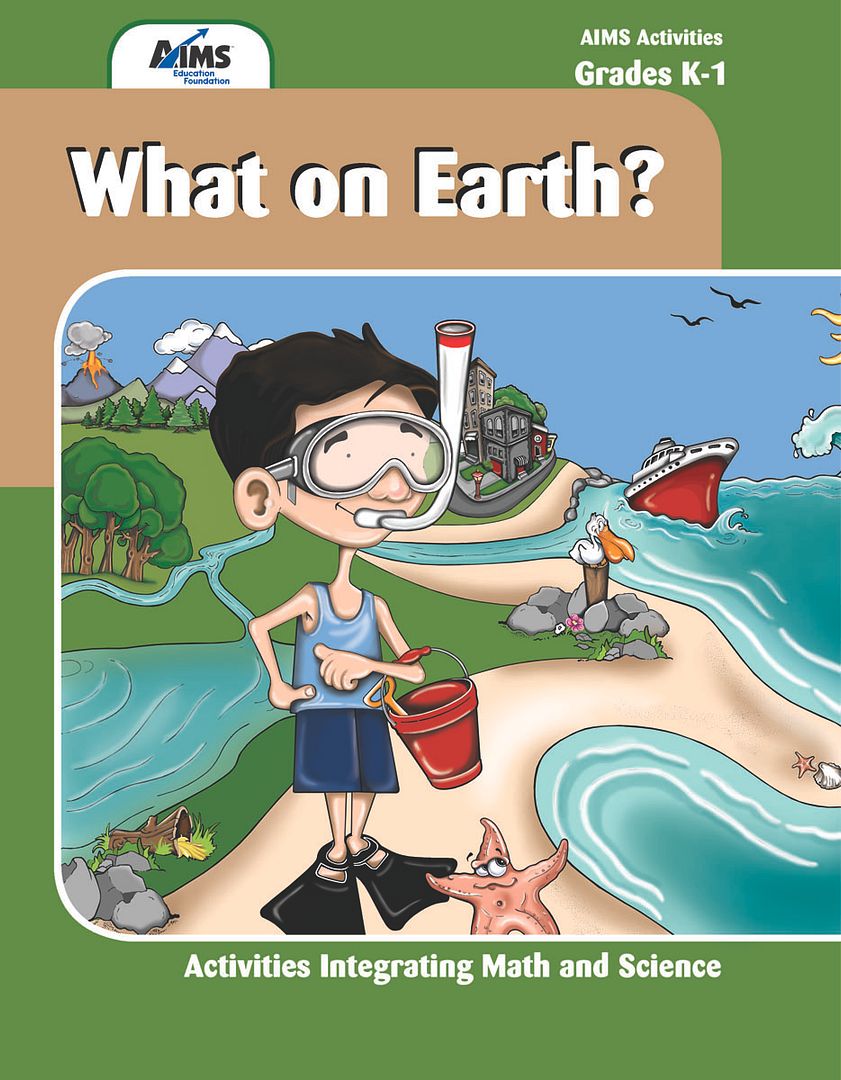Over the last few weeks, we have had the opportunity to use a neat resource in our learning., What on Earth? from AIMS Educational Foundation.
AIMS stands for Activities Integrating Math and Science. The foundation was started in 1981 with a grant from the National Science Foundation. The goal of this non-profit education is to provide teachers with helpful resources to integrate Science and Math along with with other subjects. AIMS wants to provide a more meaningful integrated approach to learning rather then dividing the different subjects.
What on Earth? is a 137 page teacher resource and idea book for teaching about what's in, on, and changing about the Earth. It is written for ages Kindergarten and First grade, though the lessons were easily adaptable for my 4 year old. The book also includes a CD so that you don't have to copy the reproducible pages, you can print them off!
Themes included in What on Earth:
What did we think?
- Resources: The Earth has resources that are used to make all kinds of things. Resources can be conserved by recycling, reusing, and reducing their consumption.
- Rocks and Soils: Rocks and soils have observable properties.
- Water: Water is found in oceans, lakes, ponds, and rivers.
- Changes: Earth's surface can quickly change due to hurricanes, earthquakes, volcanoes, and wind and wave action.
- Day/Night: The sun and moon are objects in the sky that have repeating patterns of movement.
- Seasons: The seasons form a repeating pattern. The changes in weather help determine our clothing and activities.
What did we think?
Well, we have been learning about Landforms already, so I chose the unit on Water. It went really well and the kids seemed to enjoy the lessons.
The first lesson in the unit talks about different types of Waterscapes. The CD included with the book has a bunch of beautiful photos showing examples of the different Waterscapes: lakes, ponds, rivers, streams, and oceans. Mustang and Charger especially liked seeing them. We also drove by a number of Waterscapes and discussed which was which.
The second lesson in the unit taught about the properties of water. This lesson involved water, sand, pouring, and general messiness, so we moved it outside.
Mini Cooper checking out our makeshift water bed. (Excuse the landforms, we were supposed to use books, but the landforms are plastic and we were getting ready to use them, too.)
We poured water down our pan of sand to see what would happen to the water and the sand.
The sand in the bottom pan after running down the 'land.'
Making observations about the water before and after.
This demonstration was very simple to prepare and even easier to show the kids. They seemed to understand the point, that water collects sand and other particles as it flows. It helped to actually see it in action. The rest of What on Earth? seems to be just as easy to understand and prepare, and I am looking forward to using more units in our learning!
I think that the AIMS Education Foundation did a wonderful job of integrating the subjects as I didn't feel like anything was added just to make sure that all subjects were covered. This would be a great resource for a teacher who is trying to hit all the required learning elements, but doesn't want to do a bunch of extra stuff just to do so.
From a homeschooler's perspective, I felt that it was easy to adapt to my crew. I guess having a 'mini' class of 3, I appreciate things that are written to more then one student at a time. As I mentioned before, it was also easy to prepare (majorly important). From a Montessori perspective, I felt that the book offered a number of different lessons that could easily be turned into individual learning trays to allow for further exploration of a subject.
With 30 lessons in What on Earth?, it could certainly be used as a year's science curriculum. However, you would probably find yourself using it as a supplemental or unit study resource.
What on Earth? currently retails for $21.95 and comes with a one location license to make up to 200 copies. I would really recommend this one for a homeschool co-op group!! AIMS also offers a ton of other subjects in the same format for up to grade 9, E-Activities, a magazine, lab kits, and much more!
Some of my fellow crew mates tested other AIMS books. If you would like to read what they had to say, check out our TOS Crew Blog.
Thanks for reading and God Bless!!
Disclaimer: I received a free copy of What on Earth? in exchange for an honest review. I was not required to write a positive review.







No comments:
Post a Comment